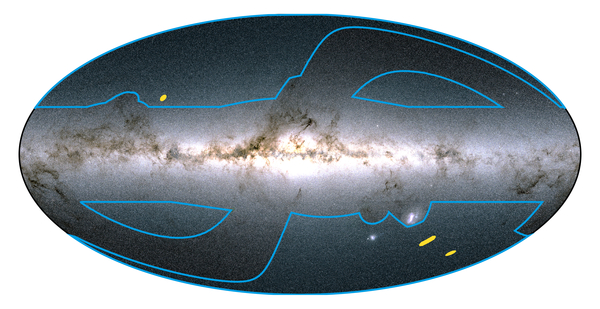Legacy science (beyond cosmology)
Although primarily designed as a tool for cosmologists to quantify the various components of the Universe in detail, Euclid's unprecedented survey will provide other astronomers with a treasure-trove of information that can be used in many fields of astrophysics.
 |
| The Euclid wide and deep surveys. Credit: ESA/Gaia/DPAC; Euclid Consortium. Acknowledgment: Euclid Consortium Survey Group |
Euclid is designed to produce a catalogue of 1.5 billion resolved galaxies using visible and near-infrared observations. This will show the shape and type of each galaxy to be measured, and produce a 'three dimensional' catalogue of them all, with distances as well as positions on the sky. It will deliver shapes and masses of galaxies, and star formation rates in those galaxies, with 4 times better resolution, and 15 times better sensitivity in the near infrared than is possible from ground-based observatories. In the near-by Universe, out to a distance of around 16 million light years, Euclid will resolve the stellar population of each galaxy it looks at.
Euclid can also provide a rich amount of detail about our own galaxy, the Milky Way, allowing astronomers to better probe its formation and evolution. Since 2013, ESA's Gaia mission has been producing a gigantic survey of almost 1.7 billion stars, or about 1 percent of the stars in the Milky Way. Euclid will augment this survey, being sensitive to celestial object approximately 100 times fainter than Gaia can detect. In addition, Euclid observes in the infrared, which will allow the detection of brown dwarfs and ultra cool stars.
In addition to detecting new objects, Euclid will also provide complementary information for stars that have already been seen by Gaia. In particular it will provide infrared colours and spectra for these objects. This new information will allow astronomers to more precisely calculate the age and initial chemical composition of each star, a problem known as the age-metallicity degeneracy. Understanding the age and initial chemical composition of each star, is critical for determining the way heavier chemical elements have built up in the Galaxy.
It is interesting to note that while our galaxy contains 100 billion stars, of which Gaia detects 1-2 billion, our visible Universe contains about 100 billion galaxies of which Euclid will image 1-2 billion.
The wide sky coverage of Euclid will also make it possible to detect nearby extremely low surface brightness tidal streams of stars. These are the remains of smaller galaxies that have merged with the Milky Way.
In the final analysis, Euclid is perfectly suited to the next generation of cosmological observations. It will provide deep near-infrared imaging and spectroscopic survey data that complements current and future wide-field surveys such as ESA's Planck microwave mission, the eROSITA X-ray instrument on the Spektr-RG mission, the visual surveys from the Vera C Rubin Observatory (formerly known as the Large Synoptic Survey Telescope) and the Panoramic Survey Telescope and Rapid Response System (PanSTARRS), the radio maps from the Low-Frequency Array (LOFAR), the Murchison Widefield Array (MWA) and the Square Kilometre Array (SKA).
In addition to the science that can come out of the survey data, Euclid's database will be used as a target list for the more detailed, follow-up observations that will be made from future telescopes such as the NASA/ESA James Webb Space Telescope, the European Southern Observatory's ground-based Extremely Large Telescope (ELT), as well as existing facilities such as the Atacama Large Millimeter/submillimeter Array (ALMA), the Very Large Telescope (VLT) and other current 8m-class telescopes.
It is possible that the number of scientific papers produced from Euclid's legacy data will outnumber the papers produced from its primary mission of investigating some of the most fundamental problems in cosmology.
| Read more |
| 1: Mission science |
| 2: What is dark matter? |
| 3: What is dark energy? |
| 4: What is gravitational lensing? |
| 5: What are baryonic acoustic oscillations? |
| 6: Legacy science (beyond cosmology) |
